Easy weeknight recipes can also be healthy and delicious! These anti-inflammatory salmon soba noodle bowls come together in about 20 minutes and are packed with flavor.
Hearty and flavorful buckwheat soba (my favorite noodle), is paired with a savory sesame-soy sauce, creamy avocado, some crunchy pals in the form of cucumber and edamame, and a lovely, super easy-to-make baked salmon.
Recipe: $19.18 | Per Serving: $4.80 | Yield: 4
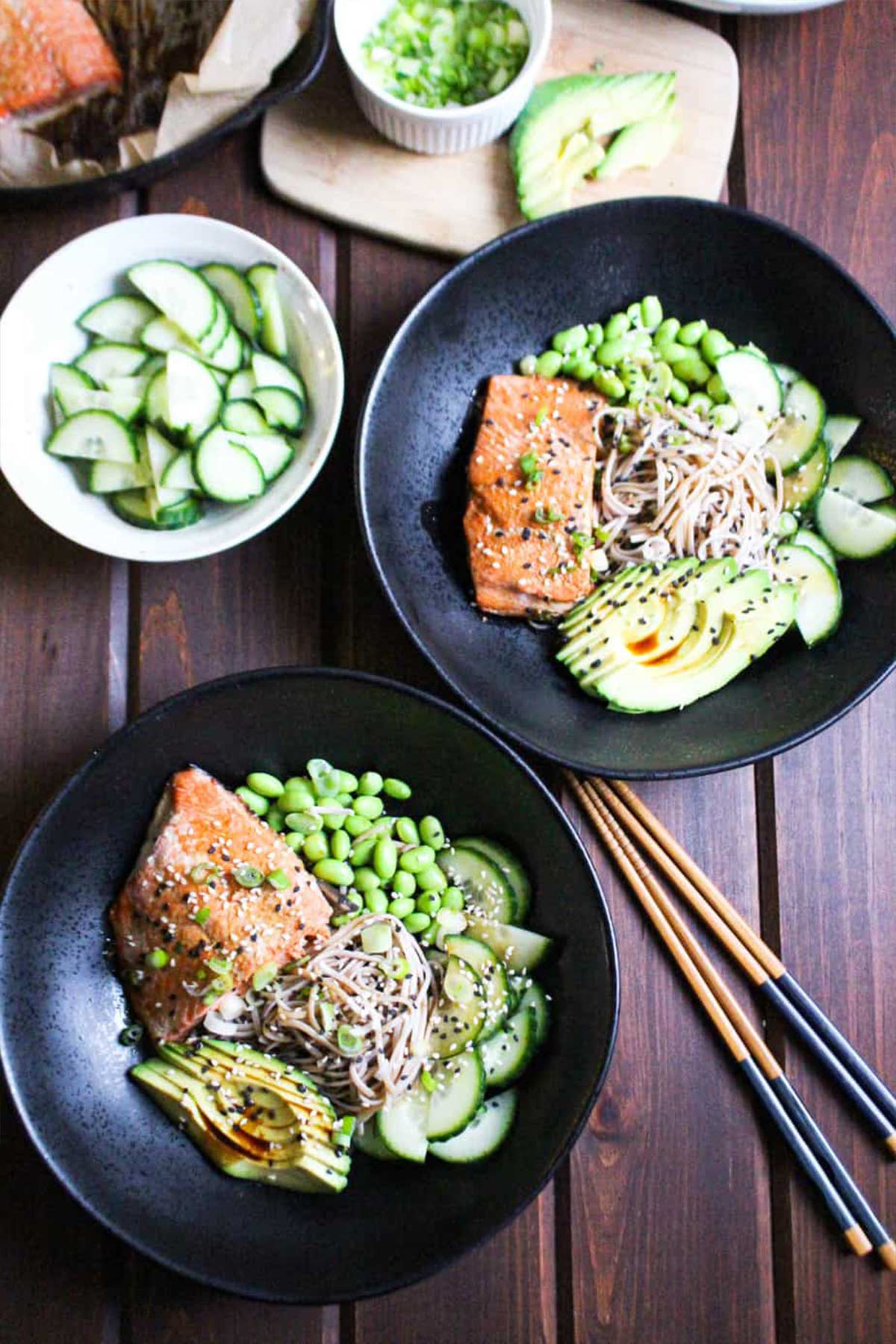
Salmon and avocado are anti-inflammatory powerhouses, but eating a colorful whole foods diet, in general, is a great way to get tons of anti-inflammatory compounds on a daily basis.
This dish is one of my favorites because not only is it fast and nutritious, but it is also surprisingly delicious. The combination of creamy avocado and rich flavorful salmon is one of my favorites and buckwheat soba is my all-time favorite noodle.
If you're looking for more ways to add salmon to your meals, try these salmon seaweed rolls and this pesto salmon sheet pan dinner.
Jump to:
- What are Soba Noodles?
- Why You Will Love This Soba Noodle Bowl
- Ingredients
- Dietary Modifications and Variations
- How to Make Salmon Soba Noodle Bowls
- How To Store Salmon Soba Noodles
- What Makes These Anti-Inflammatory Salmon Noodles?
- Expert Tips
- Recipe FAQs
- More Soba Noodle Recipes
- Anti Inflammatory Salmon Soba Noodles
What are Soba Noodles?
Soba (そば) is a Japanese noodle that is served cold or hot. Soba is traditionally served on New Year's Eve just before midnight as a good luck dish called Toshikoshi Soba.
Soba is unique because it is made from a combination of buckwheat flour and regular wheat flour, giving it a great texture but more flavor than many other noodles.
You can also find gluten-free buckwheat soba noodles that are usually made from either 100% buckwheat (affiliate) or a combination of buckwheat flour and brown rice flour (affiliate). These will have a stickier texture, but are still delicious.
Why Add Soba to Meals?
There are two reasons why I think soba is special and makes a great addition to meals!
One, buckwheat is delicious! I love the unique flavor it brings to meals. Second, soba is actually higher in protein than some other grains, including rice noodles.
Buckwheat is not a 'complete' protein, like animal meat, but it does contain thiamine, which is missing from rice, and lysine, which is missing from whole wheat. So you're getting a wider array of essential amino acids!
So if you're looking for a way to shake up noodle night, soba is your friend!
Why You Will Love This Soba Noodle Bowl
- It's perfect for a fancy dinner for company or date night!
- So fast and easy! It's a great meal for busy weeknights.
- Incredibly nutrient-dense and anti-inflammatory.
- While it's a bit pricier than other recipes on Frugal Nutrition, it's still cheaper than four servings of fast food or takeout! (Plus, way more nutritious, and way more delicious!)
Ingredients
Here's a look at the ingredients you need to make anti-inflammatory salmon and soba noodles.
Be sure to check the recipe card for the full list of ingredients and quantities of each.
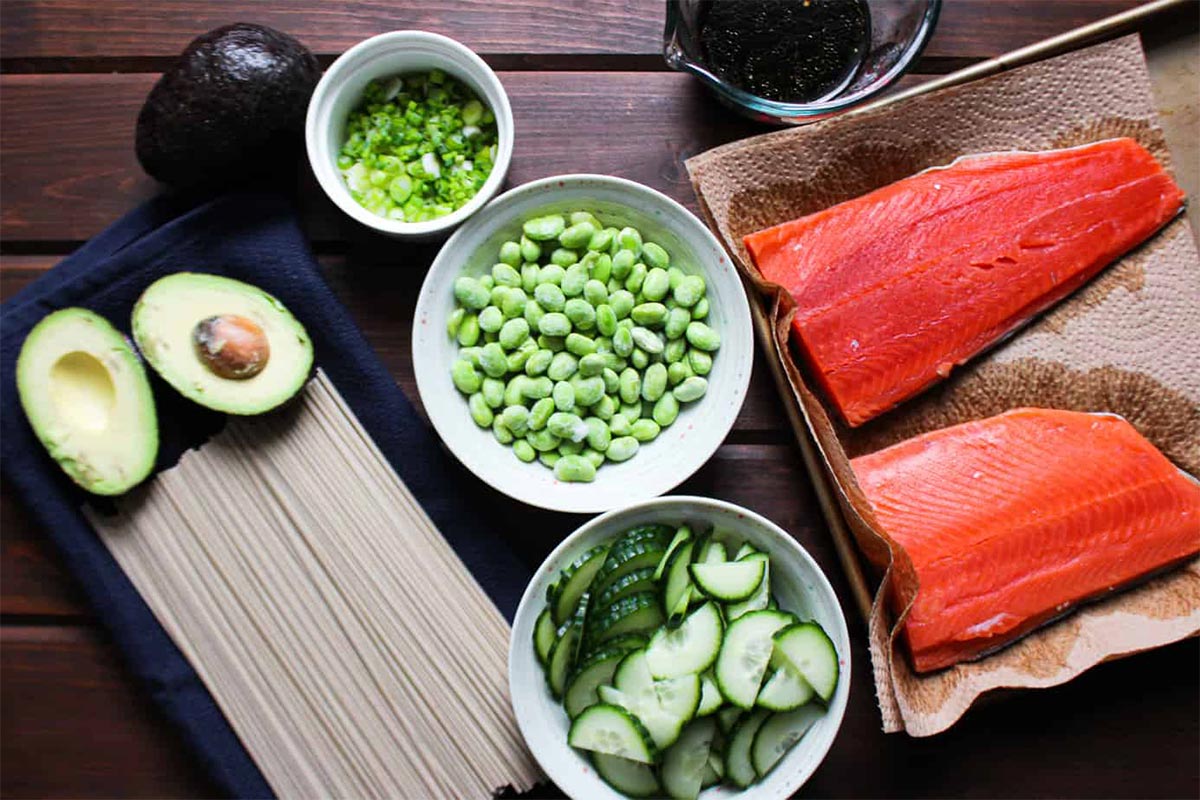
- Tamari/soy sauce: this brings the umami-rich flavor to the sauce, which makes the salmon taste incredible.
- Rice vinegar: I use unseasoned rice vinegar which doesn't contain sugar, but feel free to use seasoned rice vinegar if you prefer.
- Sesame oil: Use toasted sesame oil for the best flavor.
- Ginger: You definitely want to use FRESH! It tastes way better than dried.
- Wild salmon: Wild salmon is my preference, but there are some salmon farms that combine sustainability with decent treatment of the fish (fed their natural diets, more room to swim). You can use whatever salmon you can access and afford.
- Soba noodles: Japanese soba is best of course, but not all soba noodles are gluten-free. If you need a gluten-free option, try this brand of gluten free buckwheat soba.
- Edamame: You can find this in the frozen vegetable section of the grocery store. This recipe was written with shelled edamame in mind, but you can use unshelled if that's all you can find.
- Cucumber: Use an English cucumber which is crisper and contains fewer seeds.
- Sesame seeds: You can use black or white sesame seeds! Even better, a combination of the two looks spectacular.
Dietary Modifications and Variations
Looking for a few ways to change up your bowl of soba noodles and salmon? Here are a few suggestions.
- Vegetarian: No - salmon is not vegetarian! But it is pescatarian. Try a salmon-ish seared tofu instead.
- Paleo: No - edamame, tamari, and buckwheat are not considered Paleo (but this is gluten-free if you use gluten-free 100% buckwheat soba).
- Low FODMAP: Skip the green onions and yes this is Low FODMAP! Just follow the serving sizes of the avocado, edamame, and soba as this is technically 'FODMAP stacking' and can cause some symptoms.
- Swap the Soba: You can use brown or white rice noodles instead with great results!
How to Make Salmon Soba Noodle Bowls
These salmon soba noodle bowls come together in just a few easy steps. Here's a look at the highlights.
- Make the Sauce. Combine the rice vinegar, tamari, sesame oil, maple syrup, and ginger in a small bowl and mix together. Set it aside.
- Cook the Salmon. Place the salmon skin-side down on a parchment-lined skillet or sheet pan. Drizzle with the sauce and bake until it's cooked through.
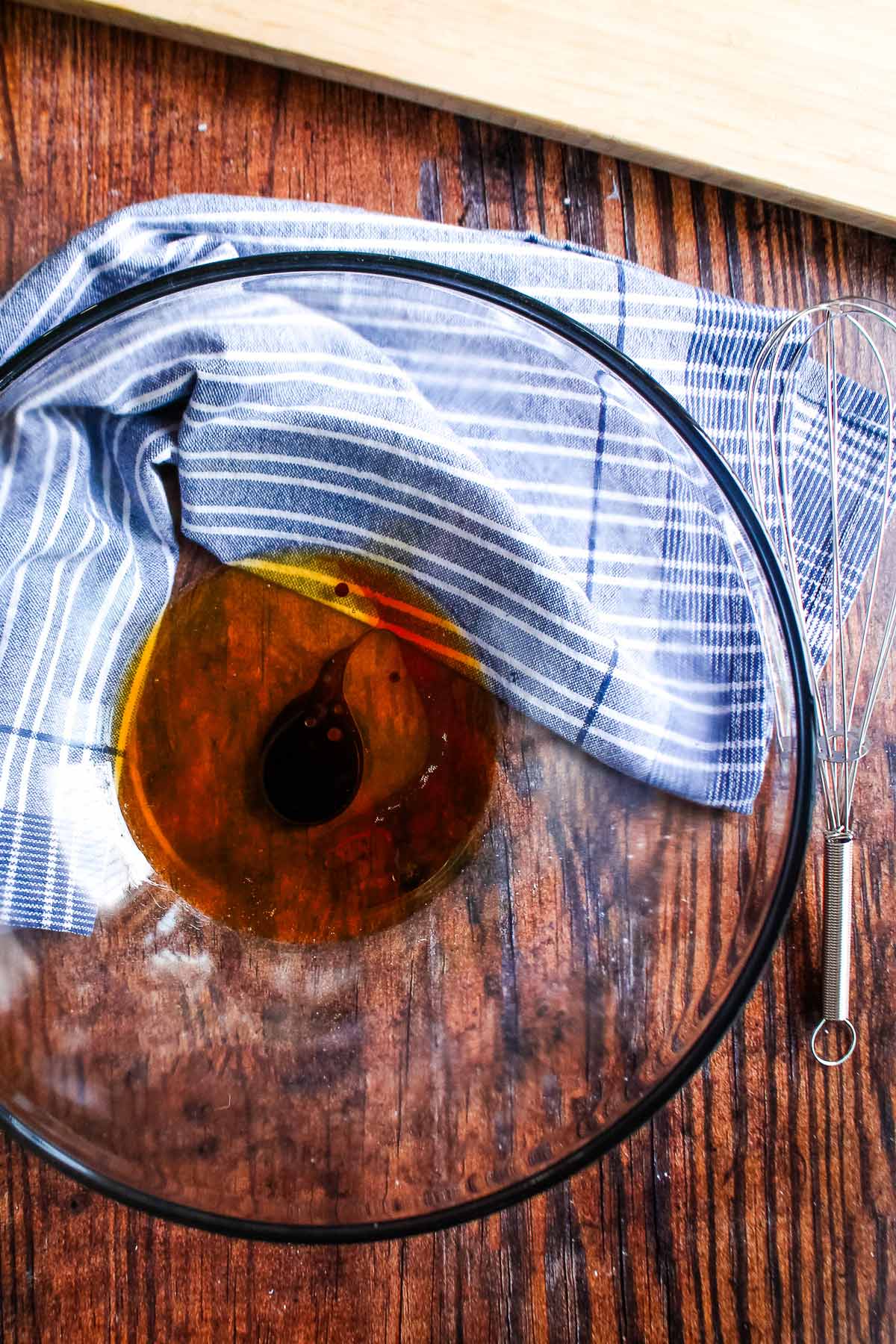
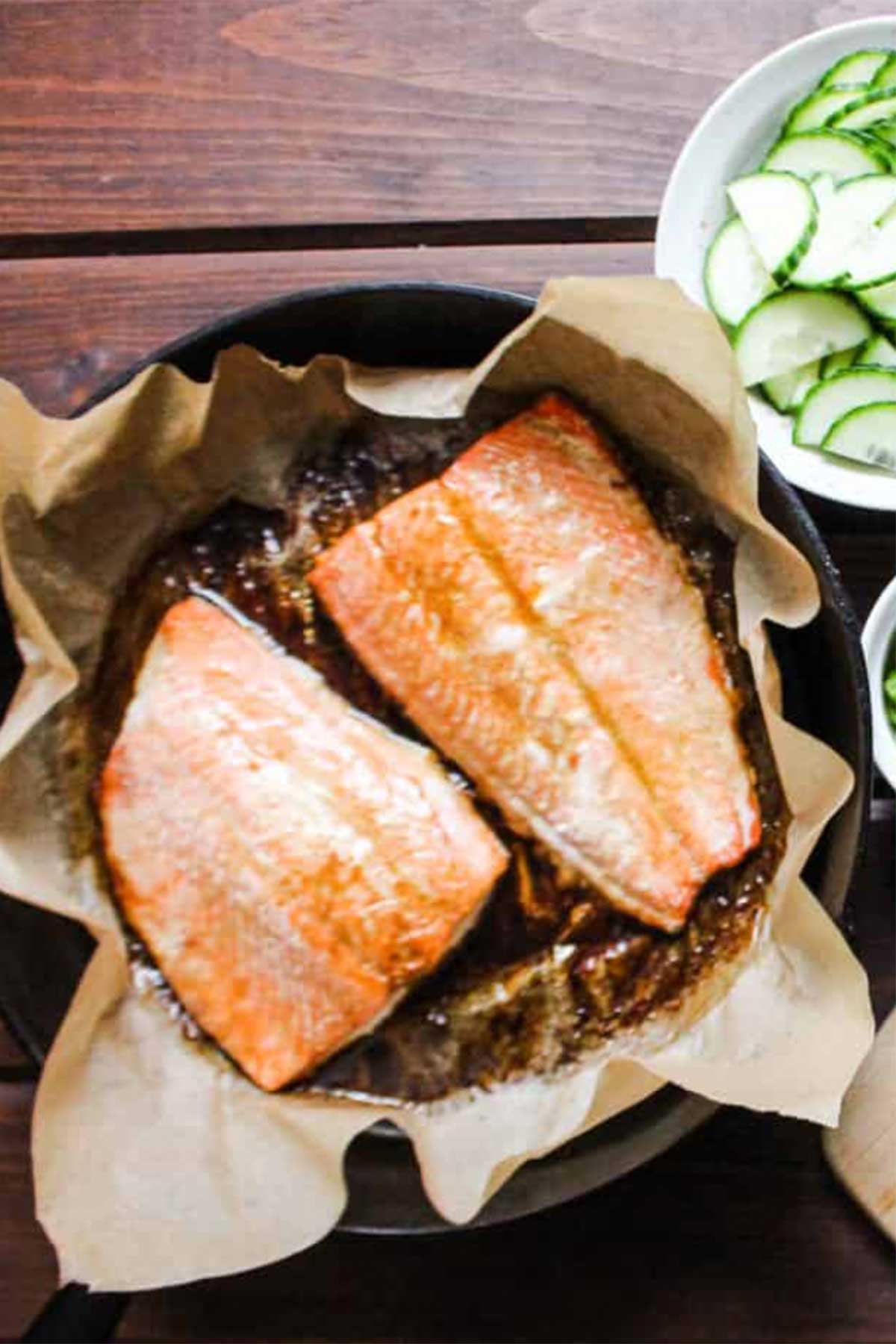
- Cook the Soba and Edamame. Cook the soba in boiling water on the stove following the package directions. Add the frozen edamame in the last four minutes of cooking or you can also pour boiling water over the edamame and let it sit for 3-4 minutes.
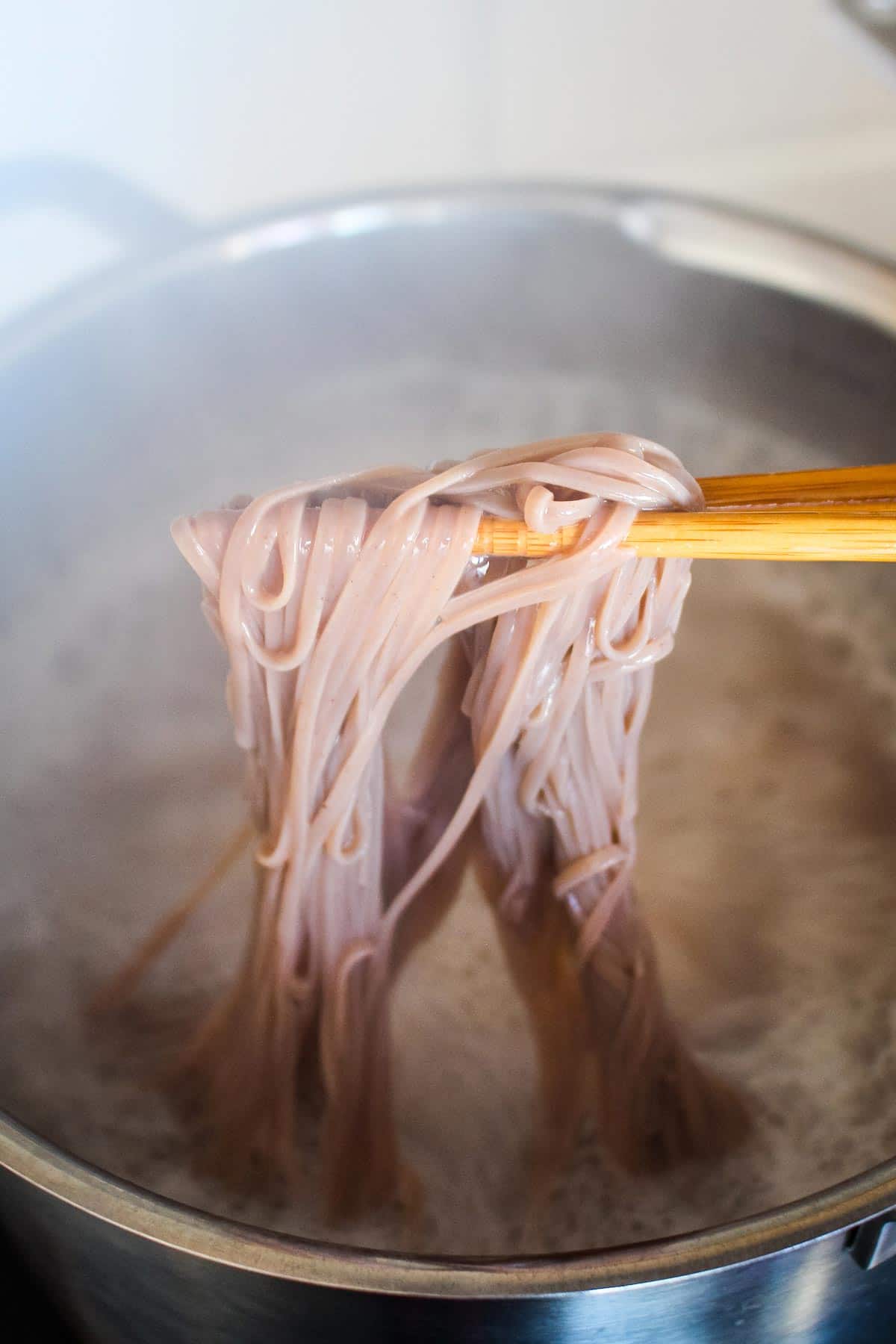
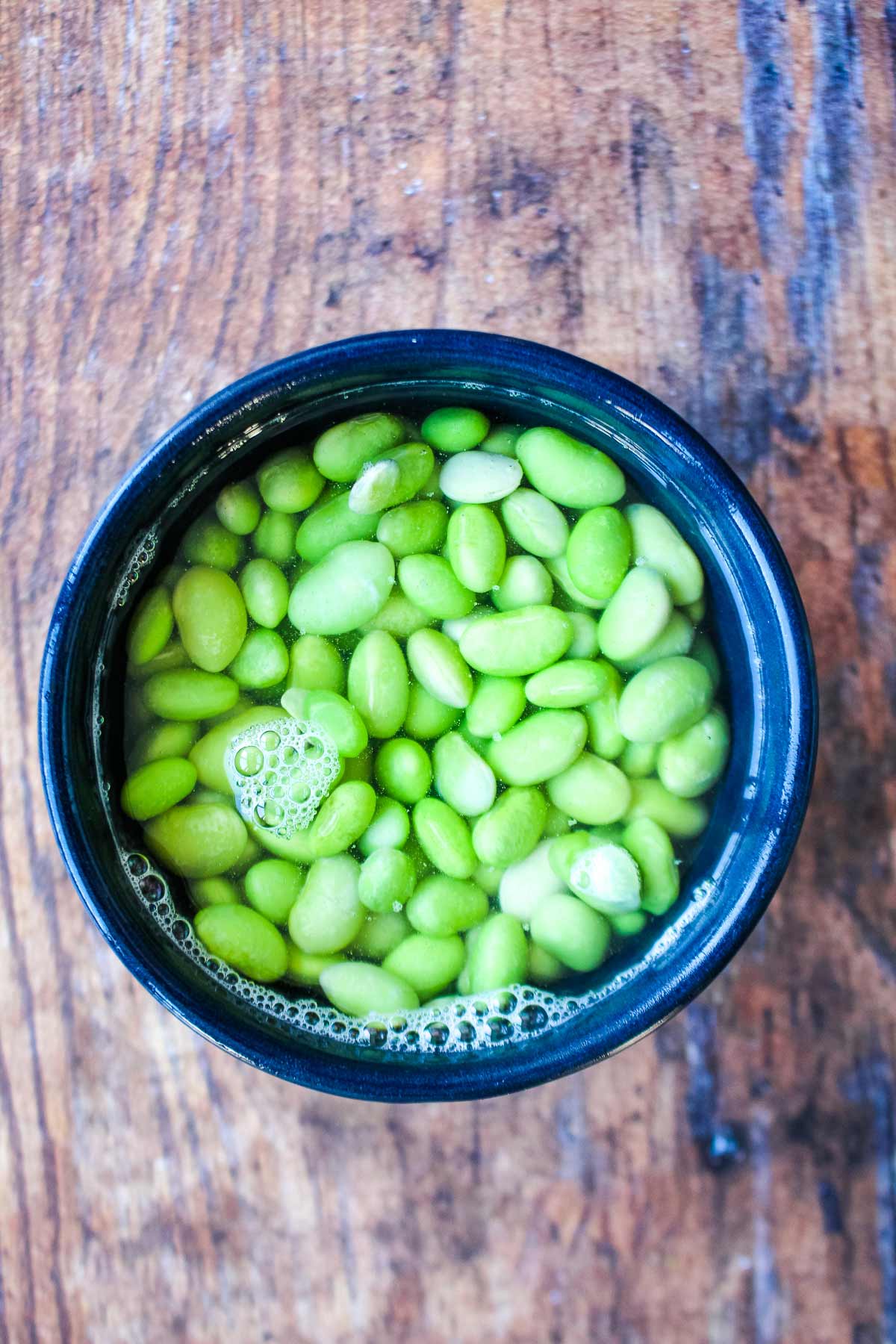
- Drain the soba noodles (and edamame) and then toss with a bit of oil to prevent sticking.
- Prep the Toppings. Thinly slice the cucumber into half moons, slice (or cube) the avocado, and thinly slice the scallions. Mix together black and white sesame seeds if using both.
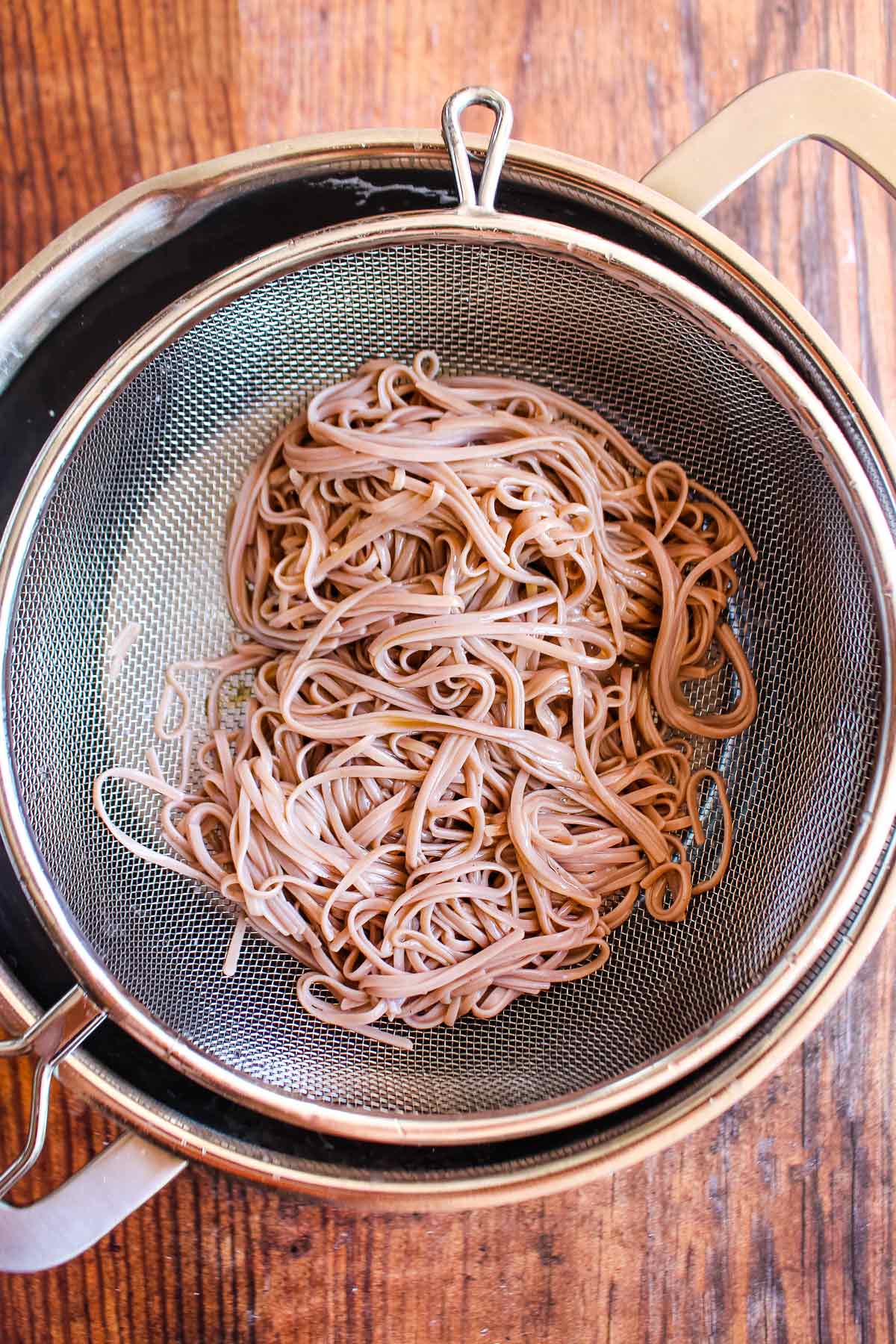
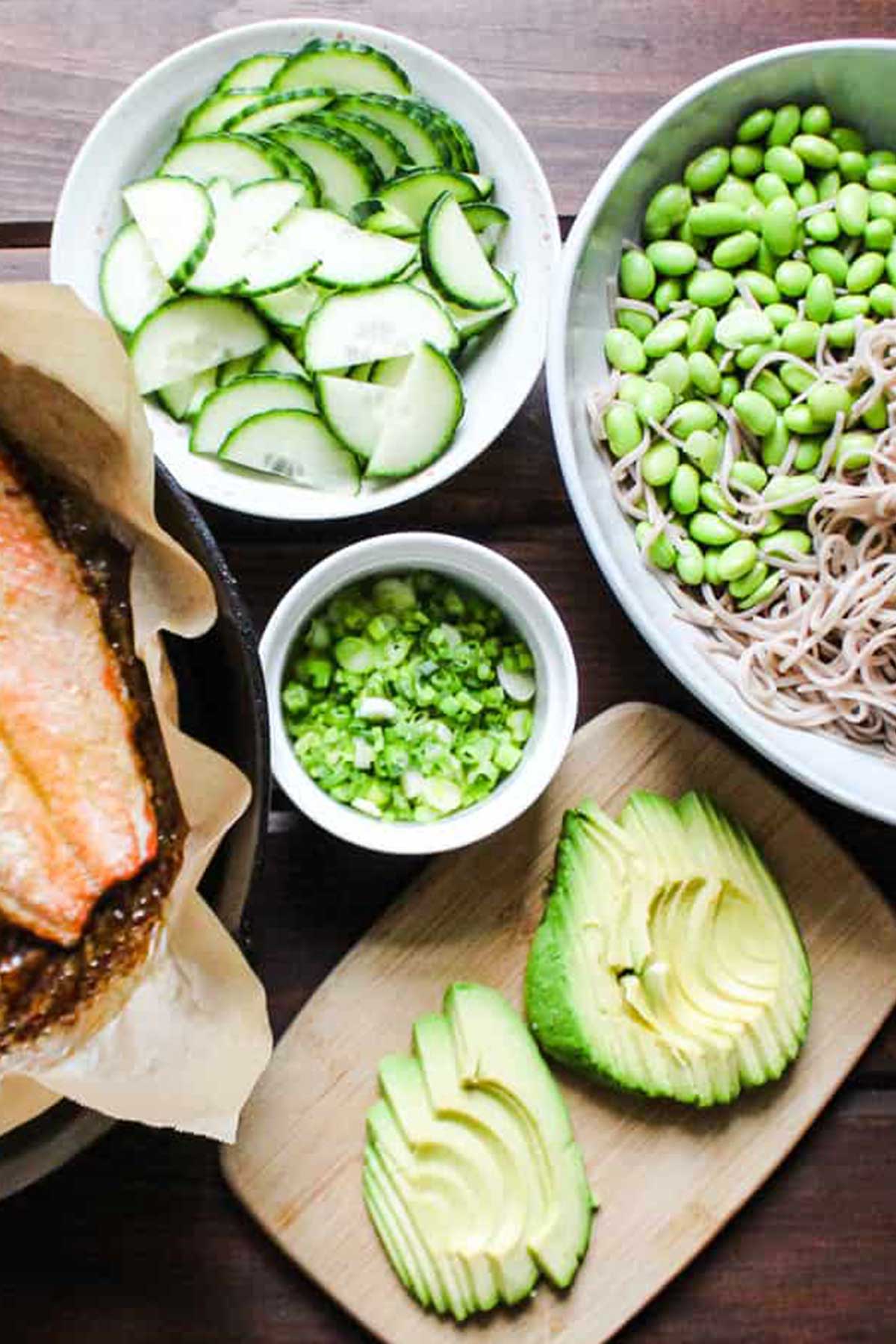
- Assemble the Bowls: Divide the soba and edamame among four bowls. Add a piece of salmon to each, and top each bowl with even amounts of the cucumber slices, avocado, scallions, and sesame seeds. Drizzle with plenty of sauce and enjoy at room temperature.
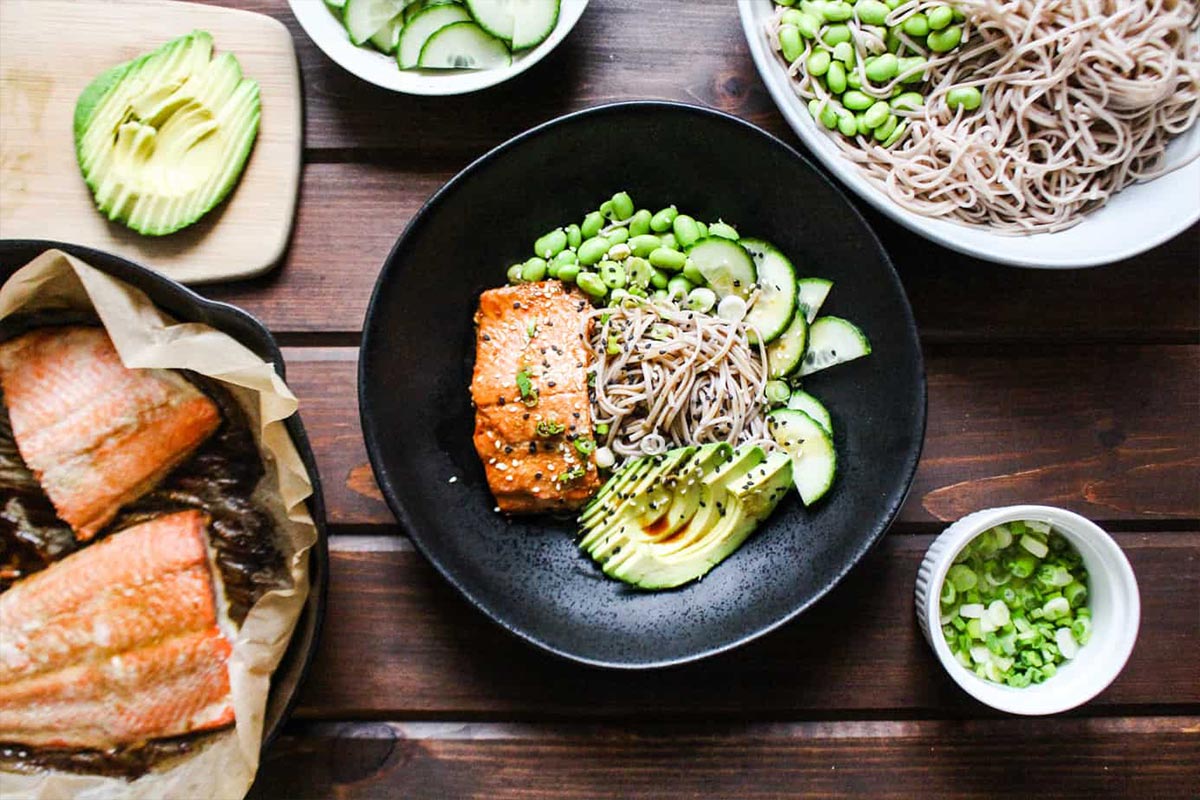
How To Store Salmon Soba Noodles
Soba noodles with salmon are best consumed fresh (soba gets a little clumpy in the fridge), but will work fine as leftovers.
You can warm this up or enjoy it straight from the fridge. To reheat: nuke the dish in the microwave in 30-second increments until heated to your preference. If desired, you can warm the salmon up in the oven separately on 325ºF for 6-8 minutes.
To store, refrigerate this for 3-4 days. You can also freeze the salmon (separately) for up to one month, but the rest of the bowl is not suitable for the freezer.
What Makes These Anti-Inflammatory Salmon Noodles?
While there are LOTS of good things in this salmon noodles recipe, here are the ingredients that boost the anti-inflammatory power of these salmon and noodles!
- Avocado: Provides healthy monounsaturated fats and carotenoids. Plus, a few not-yet-understood compounds that are especially anti-inflammatory.
- Salmon: Packed with omega-3 fatty acids and is one of the richest sources of this potent anti-inflammatory nutrient.
- Colors: Cucumber, though not a super rich source of nutrients, does contain some vitamin C and other antioxidants, and the same goes for green onion, edamame, and avocado! All green foods contain magnesium and phytonutrients! (More on phytonutrients here, study results in human health here and a printable guide to them here!)
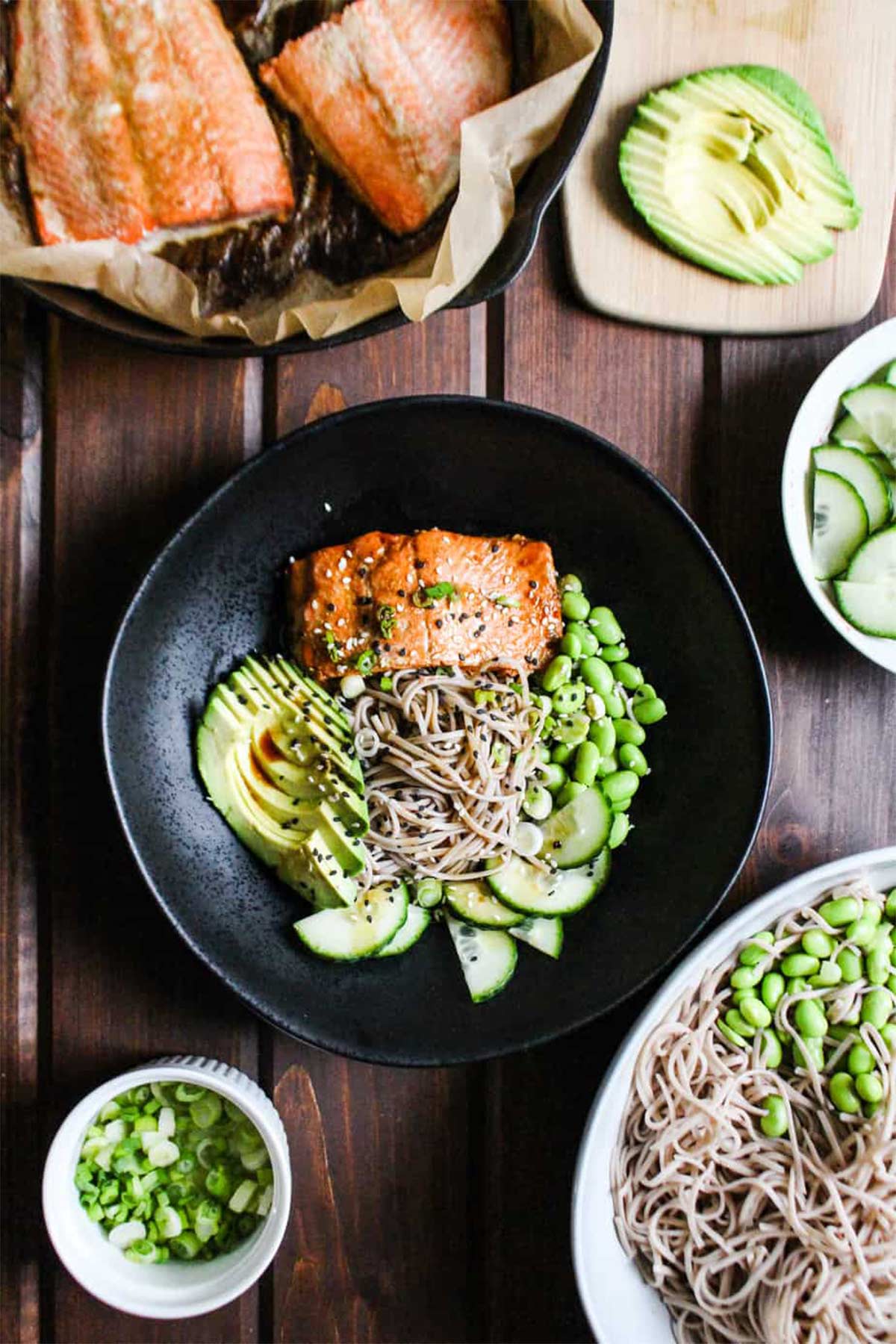
Expert Tips
- Make sure to rinse the cooked soba and toss with oil. This keeps them from sticking together and is especially important if you're using gluten-free soba noodles.
- If your soba still sticks together after storing, cover it in boiling hot water for 10 seconds and shake loose using chopsticks. Then drain off the water and enjoy!
Recipe FAQs
Many of these ingredients are more expensive than your average budget-friendly recipe but here are some tips to make this recipe cheaper.
First, reduce the salmon and increase the edamame. Edamame is much cheaper so increase it to two cups and reduce the salmon serving to 1.5 ounces per person.
Second, swap the wild salmon for farm-raised salmon. Farm-raised salmon is not technically quite as "anti-inflammatory" because the omega-3 fatty acids are lower, but it is certainly still a great source of protein if that's what you can afford.
Last, use regular (not gluten-free) soba noodles which are usually $1-$2 cheaper per package. Another option is to use brown rice or rice noodles instead of the soba.
Soba contains more protein and is also a good source of thiamin and manganese. These noodles also boast soluble fiber and may support heart health by lowering cholesterol and blood pressure.
Soba noodles, especially in this dish, can be enjoyed at all temperatures. You can enjoy them hot right after preparing all your ingredients but this dish still tastes great at room temperature or cold. I love this because it makes it perfect to carry to work or school without needing access to a microwave.
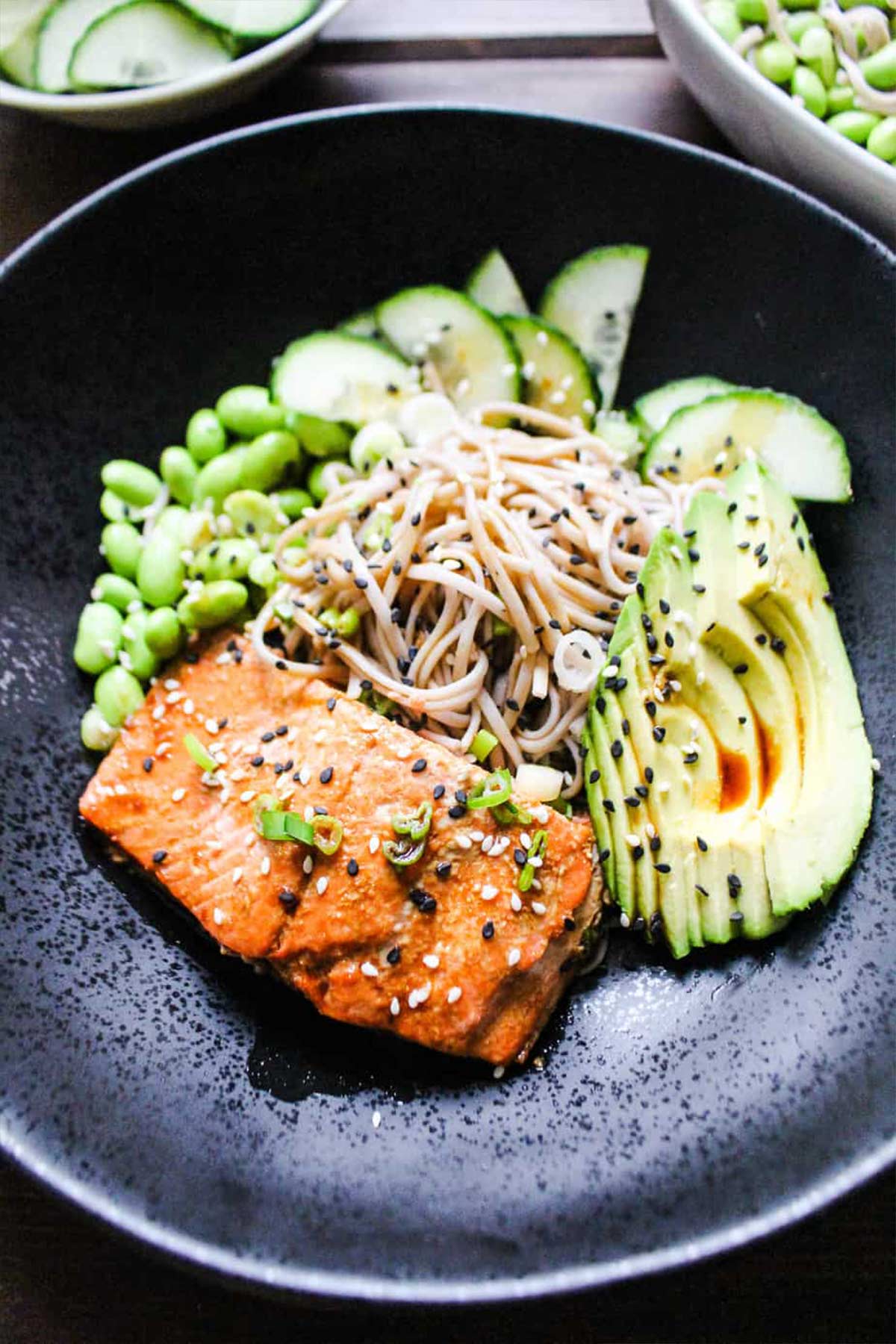
More Soba Noodle Recipes
Did you like this recipe? If so, please take a moment and give it a 5-Star ⭐️⭐️⭐️⭐️⭐️ review and leave a comment further below! Don't forget to follow me on Facebook, YouTube, Instagram, and Pinterest for more delicious recipes!
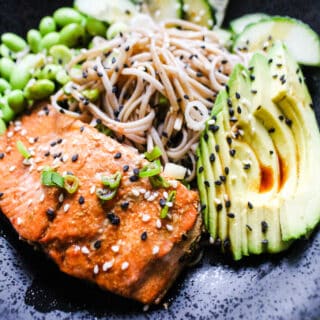
Anti Inflammatory Salmon Soba Noodles
Ingredients
For the Sauce:
- ¼ cup tamari
- 2 Tablespoons rice vinegar unseasoned / unsweetened
- 2 Tablespoons sesame oil toasted is more flavorful
- 1 Tablespoon grated fresh ginger
- 1 teaspoon maple syrup
For the Salmon Soba Bowls:
- 12 ounces wild salmon
- 8 ounces gluten free buckwheat soba (+ a drizzle of oil as needed) 360 grams
- 1 cup frozen edamame
- 1 english cucumber
- 1 large avocado or 2 small
- 3 scallions
- 2 teaspoons black or white sesame seeds or both!
Instructions
- Preheat oven to 375ºF.
- Combine sauce ingredients in a small bowl.
For the Salmon
- Line a sheet pan or oven-safe skillet with parchment paper. Add the salmon (skin-side down) and drizzle about 1 Tablespoon (or more) of the prepared sauce over the top of the salmon. Bake salmon in a preheated oven on 375ºF for 15 minutes. When cooked through, let cool 3-5 minutes and then cut into 4 equal pieces, about 3 ounces each.
For the Soba & Edamame
- Bring a large pot of water to a boil. Add the soba and cook according to package directions, about 6-9 minutes. When there are FOUR minutes left on your timer, add the frozen edamame. Alternatively, you can add the frozen edamame to a heat-safe bowl, cover with boiling water and let sit for 3-4 minutes. When soba & edamame are cooked, strain in a colander and rinse immediately with cold water. Drizzle soba with oil of choice and toss to help prevent sticking while you finish preparing your bad-ass dinner!
For the toppings
- Thinly slice the cucumber into half moons, slice (or cube) the avocado, thinly slice the scallions. Mix together black and white sesame seeds if using both.
For the Bowls
- Divide the soba and edamame among 4 bowls. Add a piece of salmon to each, and top each bowl with ¼th of the cucumber slices, avocado, scallions, and sesame seeds. Drizzle with plenty of sauce and enjoy at room temperature.
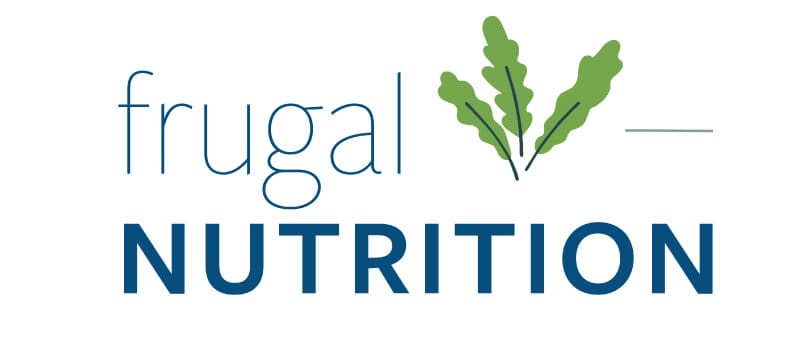

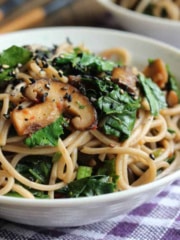
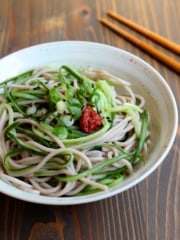
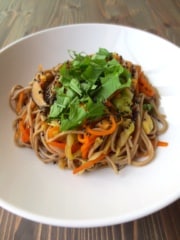
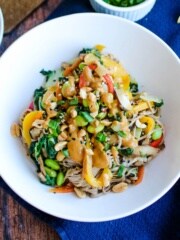
Salmon is one of my favorite fish! This combination sounds so hearty and delicious!